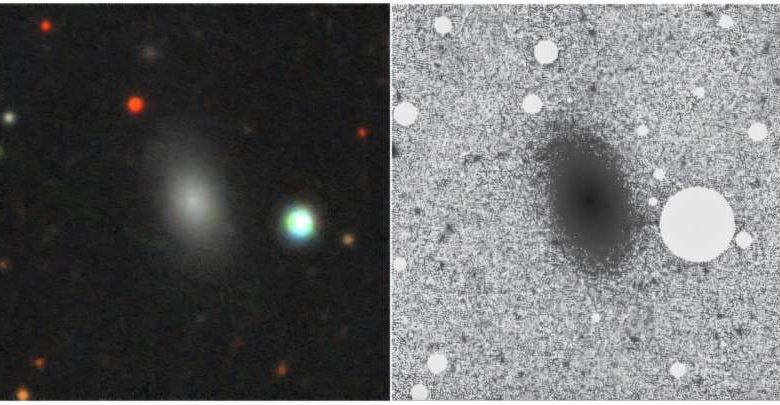New isolated early-type dwarf galaxy discovered

Astronomers from Yonsei University in Seoul, South Korea, and elsewhere report the discovery of a new isolated early-type dwarf galaxy, which appears to have run away from the group environment. The finding is detailed in a paper published August 28 on the arXiv preprint server.
Dwarf galaxies are low-luminosity and low-mass stellar systems, usually containing a few billion stars. From this group, early-type dwarf galaxies (dE) are the most common type in nearby galaxy clusters and groups.
Recent discoveries of isolated early-type dwarf galaxies, which do not belong to any galaxy cluster or group, have reignited the debate about their formation. It is assumed that some of them may be “runaway” dEs, therefore remnants of galaxies that were tidally stripped during close passages through a group or cluster and subsequently ejected to the outskirts or beyond the virial radius.
Now, a team of astronomers led by Yonsei University’s Sanjaya Paudel has identified what seems to be a runaway dE, by analyzing the data from various astronomical surveys, including the Sloan Digital Sky Survey (SDSS).
“In this study, we report the discovery of a dE, SDSS J011754.86+095819.0 (hereafter dE01+09), which appears to be located at a large distance from its host group,” the scientists wrote in the paper.
According to the study, dE01+09 currently resides in a nearly isolated region, at a projected distance of approximately 3.9 million light years from its likely host group, NGC 524. It is a quiescent galaxy exhibiting typical morphological and stellar population characteristics of a dE. In general, it showcases a homogeneous stellar population and shows no evidence of recent central star formation.
The study found that dE01+09 has an effective radius of about 3,900 light years and a mass of around 280 million solar masses. The age of the galaxy is estimated to be 8.3 billion years and its metallicity was measured to be at a level of -1.19 dex.
Trying to explain the origin of dE01+09, the astronomers suppose that it was once a member of the NGC 524 group that was ejected and evolved as an isolated system in the field. According to them, the most plausible scenario is that dE01+09 may have entered the group several billion years ago as a star-forming dwarf, where it experienced environmental quenching.
The authors of the paper added that after quenching, dE01+09 continued to orbit within the group for a few billion years. Afterward, about 3.5 billion years ago, likely a strong dynamical interaction imparted a velocity near the group’s escape speed and ejected the galaxy beyond the virial radius.
Summing up the results, the researchers underlined that the presence of a quiescent dwarf like dE01+09 in such an isolated environment is unusual; therefore, further studies of dE01+09 could help us better understand the nature of these rare dEs.





